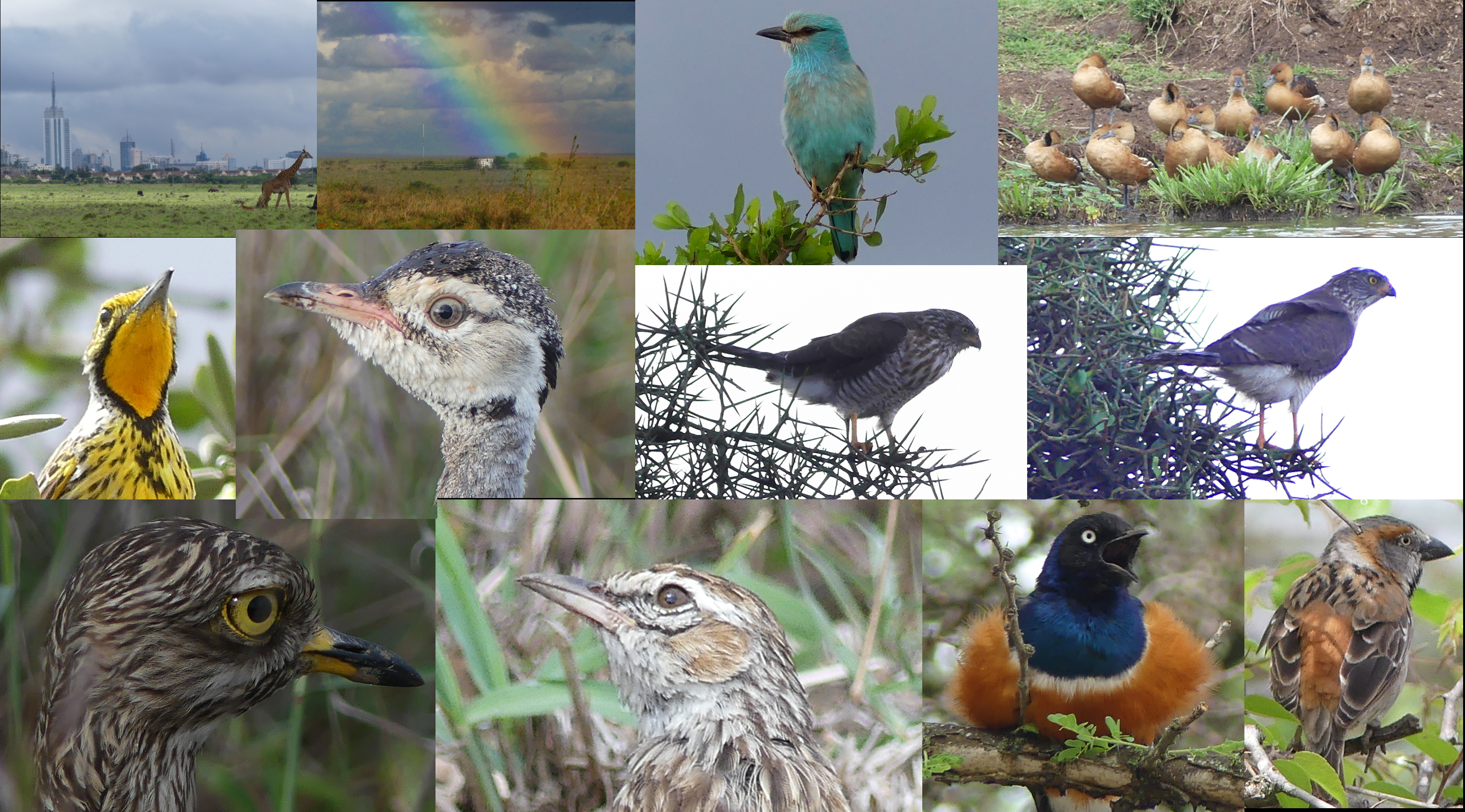From: Brian Finch <birdfinch@gmail.com>
Date: 2017-05-10 16:20
Subject: NAIROBI NATIONAL PARK 5th MAY 2017
NAIROBI NATIONAL PARK 5th MAY 2017
Dear All,
Karen Plumbe kindly collected Mike Davidson and myself, and we met up
with Fleur Ng’Weno and Jennifer Oduori at the Main Gate at 6.30am,
coupled with a traffic less Magadi Road and also Langata Road made for
a good start to the day. There was no visitors in the paying station
and we were through immediately.
There had been some recent rain, this made several places dodgy to try
and access, the back road to Hyena Dam was hazardous, Athi Dam was
muddy but we got through, as were parts of the road near Langata Gate.
With virtually all migrants having winged away, it was expected to be
quiet on the rarity front, and it was however a “nice” day and plenty
around to make it interesting and todays montage reflects a “nice” day
with some appreciation of the non-headliners!
Starting off at Ivory Burning Site we found the first Willow Warbler
of the ten seen today, but nothing else tried to steal any limelight.
The Zanzibar Sombre Greenbul sounded cheerful as always, and fifteen
Chestnut Weavers flew through.
On the Nagalomon Causeway was what is likely our last Common
Whitethroat for this season, whilst the dam was quiet with a couple of
White-faced Whistling Ducks, a few African Spoonbills, no herons of
any description, seven Darters and a trio of Grey Crowned Cranes.
There were no migrant waders, and just one adult African Jacana.
Taking the main road to Hyena Dam there were a few of the three normal
widowbirds, all being in breeding plumage, and at the dam 13 Fulvous
Whistling-Duck is the largest concentration of the species I have seen
in NNP, four White-faced Whistling Duck had nothing to do with them
and a pair of Red-billed Teal kept to themselves. The immature Glossy
Ibis is still present, several African Spoonbills, two more pairs of
Grey Crowned Cranes, and a Great Egret. No migrant waders at all apart
from eight Black-winged Stilts, whilst there were twelve Long-toed
Plover and this included the southern white-winged bird, four
Spur-winged Plovers were also on the Causeway, plus three adult
African Jacanas but little else in the waterbird line. There were the
first of about twenty Barn Swallows seen today, whilst Lesser Striped
and Red-rumped Swallows were involved in nesting activity in many
corners of the Park.
Circling around to cross the Mokoyeti Bridge there were a pair of
Lanner Falcons, two fairly latish Eurasian Rollers, the first of just
two Red-backed Shrikes today. There was a male Saddle-billed Stork
near Kingfisher, and heard but not seen were some convincing
overflying Red-headed Lovebirds which sounded as if they were heading
towards Ongata Rongai direction. Along the southern road there were a
few Pangani Longclaws and a pair of Long-billed Pipits. Raptors apart
from the numerous White-backed Vultures and five Black-shouldered
Kites were restricted to three Tawny Eagles, also in the air were a
few African Black Swifts and an African Firefinch trilled in bushes
below Baboon Cliffs.
Athi Dam reflected the quietness, in fact there was hardly anything at
all around the edge. The only palearctic wader of the day was a single
Common Sandpiper and the dirty White Stork was still here, and just
one Black-crowned Night-Heron roosting on the causeway. A single adult
Fish Eagle was in residence, and the first of two Lesser Grey Shrikes
was on the exit road.
Crossing the grasslands we had two Gabar Goshawks, a White-bellied
Bustard, a delightful family of four Spotted Thick-knees, a pair of
Shelley’s Francolins, the first Rufous-crowned Roller in quite a while
and one Rosy-breasted Longclaw. Back on the Mokoyeti single Great and
Yellow-billed Egrets, and the immature Martial Eagle.
We were through the gate at 5.50pm having recorded 155 species.
There was a good variety of mammals, perhaps the most memorable was
the abundance of White Rhinos, maybe over a dozen, and frequently two
adults sized beasts with a young one in tow. It was a great day and we
were entertained throughout, and some nice “spring” flowers are now
making an appearance.
Best to all
Brian
KEY TO THE MONTAGE
TOP FAR LEFT
HYENA DAM PLAIN TOWARDS THE CITY
In this vista are Buffalo, Giraffe, Impala, Eland, Kongoni, White
Rhino, Common Zebra, Ostrich and Crowned Cranes….. where else but NNP
could provide such a contrast of conservation meeting bedlam!
SECOND RIGHT FROM TOP LEFT
WEATHER STATION
Plans are already underway to excavate the area to find the pot of gold!
SECOND LEFT FROM TOP RIGHT
EURASIAN ROLLERS
A couple of laggards.
TOP FAR RIGHT
FULVOUS WHISTLING-DUCK
This thirteen is the largest number I have ever seen together in NNP,
it is very scarce at any time.
SECOND ROW FAR LEFT
PANGANI LONGCLAW
After the recent rain they have become very showy.
SECOND ROW SECOND FROM LEFT
WHITE-BELLIED BUSTARD
Strangely the only bustard see the whole day.
SECOND ROW RIGHT
GABAR GOSHAWK
These two behaved as a pair, the far right being a sub-adult and the
one to it’s left being an immature bird.
BOTTOM FAR LEFT
SPOTTED THICK-KNEE
One of a handsome family of four.
SECOND RIGHT FROM BOTTOM LEFT
FAWN-COLOURED LARK
They were doing a lot of singing today.
SECOND LEFT FROM BOTTOM RIGHT
SUPERB STARLING
A cheerful bird imitating a powder-puff.
BOTTOM FAR RIGHT
KENYA RUFOUS SPARROW
A handsome male and an under-rated bird.





